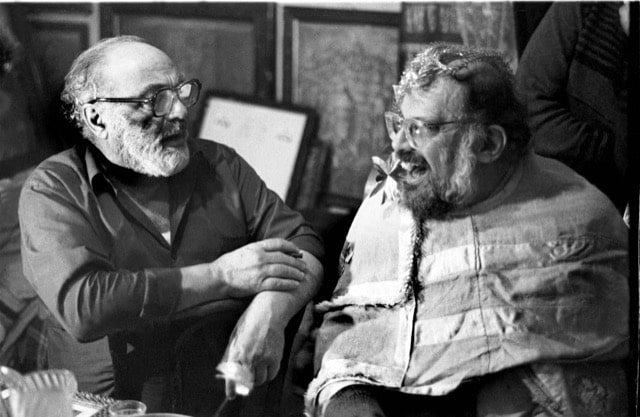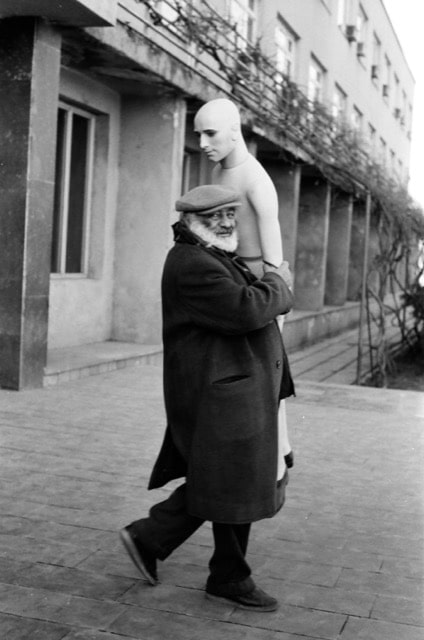Parajanov embraced by LGBTQI community in Georgia
Sergei Parajanov, a famous and influential filmmaker of the 20th century, was condemned and imprisoned by Soviet officials over his sexuality at the height of his career. Nearly a century after his birth, however, Parajanov’s arrest and lifestyle are being embraced by the queer community in Georgia.
For decades, a Soviet-era homosexuality conviction against Parajanov has been widely perceived as a politically motivated footnote in the man’s extraordinary biography.
Even though the twice married Parajanov never officially spoke about his sexual orientation, some maintain his homosexuality (or bisexuality) was publicly known and openly discussed. At the height of his career, the Soviet government accused him of raping an official. He was found guilty and sentenced in December 1973 and spent four years in three different Ukrainian labor camps. For the better part of three generations, Armenians and Georgians—both nations claim him as their own—have largely accepted that the charge and prison sentence were politically motivated.
Born to ethnically Armenian parents in Soviet Georgia in 1924, Parajanov captured the imagination of avant-garde filmmakers, artists, and actors across the globe with his gender bending films. His work helped redefined contemporary cinema in the 1960s and won the admiration of some of the biggest names in the art and film world, especially the film Color of Pomegranates. His work and his close friendships with dissidents angered the Soviet government, however, and in 1974 he was sentenced to five years in the Siberian labor camps. He was released after four.
Jean-Luc Godard, Michelangelo Antonioni and Andrei Tarkowski were among the generations of artists around the world have been inspired by Parajanov’s work, especially Color of Pomegranates.

© Yuri Mechitov
American poet Allen Ginsberg and Sergei Parajanov
“In the temple of film there are images, light and reality. Sergei Parajanov was the master of this temple,” Godard said. Most recently, American pop star Lady Gaga paid tribute to it in a music video 911. Leah Feldmann, a professor of Comparative Literature at the University of Chicago, says Parajanov has become influential among a wider group of artists over the decades, including queer artists.
“I think he definitely influenced some artwork and certainly I think there is a group of performance artists for whom his work was really influential, particularly the collage work,” she says.
One particular element of his work—Georgian Kinto dancers—has captured the attention of queer communities, Feldmann notes. Kintos were merchants or unemployed people in Georgia in the 19th and early 20th centuries whose job was to entertain other guests in restaurants. Based on their performances, a distinct male dance style developed.
“They were male dancers and … people would say they were gay. Whether that was the right perspective or not, the dancers have the particular movements which were thought of been feminine,” she says.
The Tbilisi Pride movement has adopted Kinto dancers as a symbol of the community. It added Parajanov to the queer icon hallway during the 2022 Tbilisi Pride Festival in part due to his reputation as someone who was persecuted for his sexuality.
Regardless of Parajanov’s sexuality, his struggle for the freedom to express himself makes him an attractive role model for the queer community in Georgia, which faces intense challenges as it asserts and defends its rights. Members of the community are regularly attacked and their civil rights have been questioned and threatened by the country’s ruling party and the powerful Georgian Orthodox Church.
In the face of this pressure, the Tbilisi Pride movement is actively seeking role models to encourage and empower young people to stand up for their own sexuality, notes activist Tamara Kapanadze. While there are more places for queer people to feel safe now in Georgia, there are still “lots and lots of problems when it comes to visibility.”
Parajanov does not only influence the queer community as a potential form of role model but also as an inspirational source.
“Parajanov loved this eclectic diversity because the main inspiration for creativity is to make beauty - colorful, decorative beauty,” film-critic Teo Khatiashvili says, noting that his films and his collages—an art form he developed while in prison—use deconstruction and “destabilization” to tell a story.
“It’s literally kind of putting together everyday objects in order to formulate a whole story,” she explains. “He created rituals and traditions that are always about destabilizing.”
Khatiashvili, who wrote a book on Parajanov, explains that his open approach to his own sexuality manifests itself in his aesthetics. She sees metamorphosis as the principle of Parajanov’s work, noting that in his films, he often plays with gender fluidity--for example an actress playing male and female parts. In an interview, Parajanov said that he was impressed by a Persian drawing of a couple in love sitting side by side and they have the same face. This stylized image is typical generally for Persian miniature, which influenced Parajanov and became an inspiration for Colors of Pomegranates.
Professor Feldmann says Parajanov saw the Caucasus as part of a world that is not yet nationalized, one that crosses borders. This, and a very fluid portrait of gender that combines a fluid portrait of belonging, has a kind of surreal quality, she states.
Anahit Mikayelyan, the director of the Parajanov Museum in Yerevan, agrees. “He was a person from the center of Caucasus, he came from Tbilisi where he came across every culture from this region,” she says. “He liked the process of creating. You could say he loved games, playing games--playing with scenes, with actors and actresses, with things. All this he gave life. When you watch the movie you can see that it is not just a movie - it's art which is alive.”
Parajanov died in 1990 in Yerevan. Apart from the museum, and a statue of him in his hometown of Tbilisi, there is little to mark the fact that he was from the region.
Film critic Khatiashvili notes that both Armenian and Georgian culture are still very conservative and homophobia is widespread. “I can't say that Parajanov's sexuality is now being discovered-- his homosexuality was a known fact. Another thing is that in such traditional cultures and societies as Armenia and Georgia still are,xenophobia and traditional perceptions prevent people from thinking freely, not to mention aggression against LGBT people.”

© Yuri Mechitov
Mikayelyan, the director of the Parajanov Museum in Yerevan, does not see the need to revive Parajanov as a role model in the queer community. In her eyes his sexual orientation is of no importance and queer filmmakers and queer people in general have more freedom today in Armenia. “Today…we have an educated society. It doesn’t matter in Armenia, Georgia and other countries. Today we have an open-minded, educated, young generation,” she says.
But Kapanadze notes that today few people of her generation know anything at all about Parajanov—neither Armenia nor Georgia has made much of an effort to honor his legacy or educate their societies about his contributions to art and cinema.
“1960s in the Soviet Union, it was such an interesting area. Parajanov was among the people. But now we don't learn about him at school, and we don’t learn about him at university, unless you are studying cinema or art…You could ask a person in the street and they don't know him at all,” she says.
“When we talk about queer artists, it is like they were almost nonexistent in Georgia in the past…Therefore it is important to know about him also as part of the queer community.”
Supported by the Federal Foreign Office and the Civil Society Cooperation program, implemented by the Deutsche Gesellschaft e. V.
DONATE NOW

